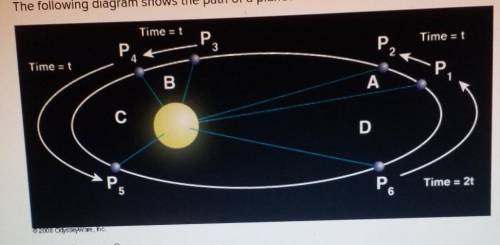
Physics, 05.05.2020 15:36, JOHNDoe3443
Please help!
SELECT ALL THAT APPLY
The following diagram shows the path of a planet around the Sun. Kepler discovered that _.
1. area A = area C.
2. the distance from P2 to P3 equals the distance from P5 to position P6
3. the speed in the interval from P4 to be P5 equals the speed in the intervals from P6 to P1
4. the speed on the interval from P4 to P5 is greater than the speed in the interval from P1 to P2
SELECT ALL THAT APPLY


Answers: 3
Other questions on the subject: Physics

Physics, 21.06.2019 18:00, justhereforanswers13
According to the law of conservation of mass, in a chemical reaction the total starting mass of all the reactants equal the total final mass of all the products. true or false?
Answers: 1

Physics, 21.06.2019 20:30, PrincessIndia
3. on your graph, the data points between the black squares are data for elements with atomic numbers 3 through 9. locate these elements on your periodic table. what term or description would you use to identify these elements with respect to the periodic table?
Answers: 2

Physics, 22.06.2019 11:00, coolfab9338
1.)the isotope cobalt-60 has a nuclear mass of 59.933820 u calculate the mass defect of cobalt-60 using the following information. mass of proton: 1.007825 u mass of neutron: 1.008665 u 1 u = 931.5 mev 2.)the isotope cobalt-60 has a nuclear mass of 59.933820 u calculate the binding energy of cobalt-60 using the following information. mass of proton: 1.007825 u mass of neutron: 1.008665 u 1 u = 931.5 mev 3.)the isotope cobalt-60 has a nuclear mass of 59.933820 u calculate the binding energy per nucleon of cobalt-60 using the following information. mass of proton: 1.007825 u mass of neutron: 1.008665 u 1 u = 931.5 mev
Answers: 3

Physics, 22.06.2019 17:50, arunamvr
Which of the following best describes internal energy? a. the difference between the kinetic and potential energies of the particles in a system b. the sum of the kinetic and potential energies of the particles in a system c. the sum of the kinetic and thermal energies of the particles in a system d. the difference between the kinetic and thermal energies of the particles in a system
Answers: 2
Do you know the correct answer?
Please help!
SELECT ALL THAT APPLY
The following diagram shows the path of a planet aroun...
SELECT ALL THAT APPLY
The following diagram shows the path of a planet aroun...
Questions in other subjects:

History, 09.04.2020 03:31

Mathematics, 09.04.2020 03:31








Mathematics, 09.04.2020 03:31






